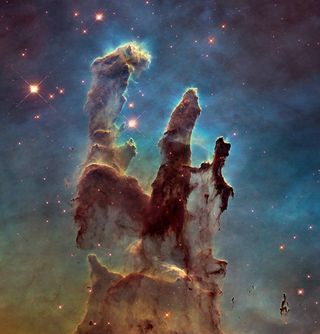- UID
- 20
- Online time
- Hours
- Posts
- Reg time
- 24-8-2017
- Last login
- 1-1-1970
|
|
━━━━━━━━━━━━━━━━━

The Pillars of Creation are towering formations of cosmic gas and dust that lie in the center of the Eagle Nebula. A research team in Japan just discovered towering Giant Elephant Trunks that are much larger than these pillars.(Image: © NASA, ESA and the Hubble Heritage Team (STScI/AURA))
▼ Ursa Major, the Tadpole Galaxy, the Crab Nebula — when it comes to naming objects in space, it sometimes seems like astronomers wish they'd gone into zoology. Continuing in this long tradition, a researcher has recently identified mammoth column-shaped structures carved from gas and dust that he has called Giant Elephant's Trunks.
Regular-size astronomical Elephant's Trunks are well-studied entities. When newborn stars are young, they emit colossal amounts of radiation, which can erode nearby interstellar gas and dust. Dense pockets of material are more resistant to this erosion, protecting downstream gas and dust from the radiation pressure and creating long filaments that resemble pachyderm proboscises, according to NASA.
Famous examples of such structures include the Horsehead Nebula and the Elephant's Trunk Nebula, as well as the highly photogenic Pillars of Creationfound in the Eagle Nebula. Researchers often investigate Elephant's Trunks because they are the sites of star birth and early evolution.
Using the Nobeyama 45-meter Radio Telescope in Japan, astronomer Yoshiaki Sofue of the University of Tokyo recently conducted a survey of the plane of our Milky Way galaxy. In two minor spiral arms 15,000 to 22,000 light-years away, known as the Scutum and Norma arms, he spotted three Elephant's Trunks, except that they were at least an order of magnitude greater in size and mass than previously seen entities.
The Giant Elephant Trunks found in two spiral arms of the Milky Way are between 65 and 160 light-years across and may be 10,000 solar masses. It's not clear yet what forms them, but it's possible that these are the sites of large-scale star formation in the galaxy. (▪ ▪ ▪)
► Please, continue reading this article here: Source |
|